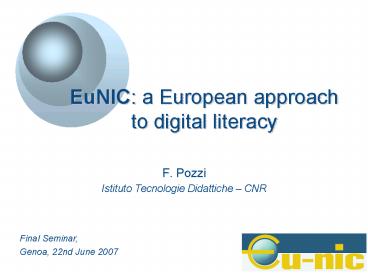EuNIC: a European approach to digital literacy - PowerPoint PPT Presentation
1 / 18
Title:
EuNIC: a European approach to digital literacy
Description:
Technology tends to change in a very fast way. The use of ICT is a no-ending learning process. A ' ... Towards the definition of a transferability strategy ... – PowerPoint PPT presentation
Number of Views:29
Avg rating:3.0/5.0
Title: EuNIC: a European approach to digital literacy
1
EuNIC a European approachto digital literacy
- F. Pozzi
- Istituto Tecnologie Didattiche CNR
Final Seminar, Genoa, 22nd June 2007
2
The EuNIC project main aim
- to promote throughout Europe a
concept-oriented approach to digital literacy,
as opposed to a technology oriented one.
excerpt from the EuNIC proposal - According to the project, this can be achieved
by adapting and transferring to other European
countries an innovative approach to digital
literacy (called NIC) developed in 2001 in Italy
by ITD-CNR, which has been widely experimented in
the Province of Genova with very good results.
3
Project activities
Analysis of the NIC approach
Analysis of the local needs
Definition of the EuNIC approach
Teacher training
Run of pilot courses
Definition of a transferability strategy
4
Starting considerations
A fluent use of technology requires experience
and real problems
Its impossible in a short training stage to
master the use of computer
Technology tends to change in a very fast way
The use of ICT is a no-ending learning process
A technical approach to digital literacy
Difficulties in facing unknown or new situation
5
The EuNIC course
- It is a face to face course for adults with
little or no previous computer skills - It focuses on a small nucleus of key concepts and
competences - It favours problem-based teaching methods as
apposed to a step-by-step explanation of the
various computer environments and programmes.
6
The EuNIC course - goals
- to help adults with no previous computer
experience become wise beginner users, - i.e. users that
- are able to interact with the computer to
perform - simple tasks
- have an overall understanding of the
logic-physical working mechanism of the computer
- are able to act independently to improve their
know how.
7
The EuNIC course - structure
Basics key concepts and skills (20 hours)
What is a computer? How does it work?
The operating system and the computer resources
What is a file differences between programs and
documents
How to create, save and edit simple documents
How to use the mouse, the keyboard, how to manage
windows
..........
8
The EuNIC course - structure
Basics key concepts and skills (20 hours)
Immersion introduction to the most common
applications by means of a work project (50 hours)
To engage students in more complex activities
requiring the use of word processor, e-mail, web
search, database, spreadsheet, hypermedia
presentations
To reinforce the basic concepts and skills of
the previous phase
9
The EuNIC course - structure
Basics key concepts and skills (20 hours)
Immersion introduction to the most common
applications by means of a work project (50 hours)
Emersion to widen the horizons (10 hours)
to situate the technology (computer history,
diffusion, related professions )
to facilitate post course personal approach to
the computer
10
The EuNIC course - structure
Basics essential concepts and skills (20 hours)
Immersion introduction to the most common
applications by means of a work project (50 hours)
Emersion to widen the horizons (10 hours)
11
The EuNIC course teaching strategy
- to introduce the contents and skills with a
little and slow method - to strictly alternate traditional lessons with
hands-on individual or pair work - to give more attention to stable concepts and
competences as opposed to technicalities - to concentrate on the problem and its
clarification rather than on the technical means
of resolving it - to engage the students in motivating activities
that will encourage the development of productive
work behaviours.
12
The EuNIC course learning materials
similar to lecture notes their function is to do
away with the need to make notes during the
sessions
13
The EuNIC teachers
- Teacher recruitment they were chosen by each
partner according to the local needs, resources
and constraints ? 13 teachers were recruited 5
from Bulgaria, 4 from Greece, 2 from Latvia and 2
from Portugal. - Teacher training they were trained by the ITD
staff through an online course called TOL
(Trainers OnLine). - Support for teachers
- an ad hoc teachers guide was developed giving
suggestions on how to set up and manage each
session - a conference was devoted to the exchange among
the teachers and between teachers and ITD staff.
14
The EuNIC pilot courses
6 EuNIC pilot courses were realized in the
partner countries and involved 60 participants.
- Working status
- teachers (in Bulgaria),
- housewives (in Greece),
- unemployed people with disabilities (Latvia),
- retired people (in Portugal).
15
Evaluation of the EuNIC pilots
- Evaluation of course quality ? as perceived by
the students and the teachers - Evaluation of course effectiveness ? in terms of
learning achievements
16
Initial results of the pilots
Students perceptions on course quality seen from
different perspectives.
17
Initial results of the pilots
Students opinions on their acquisition of
autonomy in using computers and on the
usefulness of the course
18
Towards the definition of a transferability
strategy
- to identify possible target populations as well
as key people and institutions for supporting the
dissemination of EuNIC both at national and
European level - to sketch the tools needed to train and support
the teachers.































